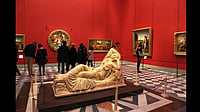Seemingly out of nowhere, the road started climbing up a steep incline—a clear indication that Mandu was not far.
We were on our way to this ancient fort city in Madhya Pradesh for the state’s marquee annual cultural festival, held this time between December 30, 2021 and January 3, 2022. Mandu lies nearly 100 kilometres southwest of Indore—an approximately two-and-a-half-hour drive from Indore through a surprisingly uniform and flat stretch of lush, green, plateau dotted with agricultural crops and harvest. As one comes close to the city however, the Vindhya Range (or Vindhyachal) rears its head—and the road leading into it features many hairpin bends over which a number of broken, arched gateways (or darwazas) still loom large.
The gateways are among the first signs that Mandu still lives and breathes history. Books state that it flourished as early as the 6th century AD, going on to experience its heyday in the 10th and 11th centuries under the rule of the Paramaras. Although, today, all one sees are the ruins of what, at one time, must have been glorious and strategically functional monuments. By some estimates, nearly 3,000 ruins are scattered over the countryside, including those of around 700 temples that were razed to the ground by successive invaders. Whether these numbers are historically accurate is a different matter altogether.

***
In the middle of all the antiquity, the Mandu Festival 2022 provided a refreshing dose of the modern with its curated experiences. The first novelty for me was the glamping site, located opposite Chhappan Mahal, under a pretty grove of trees with picturesque views of a large lake and a sprawling, magnificently old banyan tree. I was pleasantly surprised to find the tent reserved for me equipped with all the facilities needed for a most comfortable stay (including a perfectly functional toilet, non-stop supply of warm water and eminently warm blankets). And by the time I left, I had fallen in love with the mellow, yellow glow of the globular, balloon lamps that illuminated the interiors—so much so that I wanted to carry one of them back home as a souvenir.


Other events on the festival itinerary also made for a fascinating blend of the new and the old. A hot air balloon ride on the morning of December 31, 2021, revealed more reasons, from the skies above, to keep visiting Mandu and its surroundings (for instance, the numerous dry forest trails criss-crossing the Vindhyachal range). A nighttime laser light-and-sound show, featuring the voice of actor Ashutosh Rana, in the Hindola Mahal on the historically significant premises of the Jahaz Mahal transformed the area with a rainbow of colours against the backdrop of a narration of Mandu’s history. Similarly, the music district—at Echo Point, close to Dai Ka Mahal, that once housed midwives—was enlivened on the evening of the 31st by a kavi sammelan that saw soulful performances, mostly centred around hasya kavita (comic poetry), from poets such as Sandeep Sharma, Parth Naveen, Lokesh Jadiya, among others. A short distance away, on the same evening, the Rewa Kund, a must-visit stop for those completing the Narmada Parikrama, saw a first-of-its kind Narmada aarti performed by priests to the accompaniment of chants and musical instruments both old (harmonium, dholaks) and new (electronic drum/octapad). An arts-and-crafts district showcased thought-provoking, mixed-media compositions (paintings and installations included) by local, contemporary artists, while a market nearby peddled traditional handicrafts such as bagh prints—handprinted, woodblock, relief prints native to Bagh in Madhya Pradesh’s Dhar district.


The credit for organising the multitude of attractions is owed to E-Factor Entertainment, an event management company that has been selecting and curating the experiences for the Mandu Cultural Festival for three years now. Jai Thakore, E-Factor’s co-founder and COO, described their motivations for taking the lead in organising and managing the festival. “Mandu has such a rich and vibrant history and heritage that it deserves to be a destination in its own right. We want to see it flourish—people should see it as much more than a mere stopover en route to places such as Maheshwar,” Thakore explained to us. “Experiences such as glamping and hot air balloon rides are buzzwords now—and we wish to provide and make use of them to attract more people from other states to put Mandu on India’s travel map and bring it forward, into the 21st century. As a matter of fact, we intend to keep and rent out about 20 tents on the glamping grounds till June 30, 2022, in a bid to entice more travellers and enthusiasts after the festival ends,” he added. Thakore also expressed hope that they would be able to address the friction with and animosity among the locals, stemming from their lack of participation in such an extravaganza, in due time.

Getting there
By road: Mandu is 97 kilometres by road from Indore. A cab ride takes approximately between two and three hours.
By rail: Mhow (officially Dr. Ambedkar Nagar) is the nearest railhead, around 28 kilometres from Mandu. Mhow is connected to important junctions such as Indore and Khandwa by metre gauge railway lines.
When to visit: While the Mandu Festival, usually held in the beginning months of each year, provides a whirlwind experience of the city’s heritage and history, Mandu is best visited during monsoon when the dry streams overflow and the place turns several shades greener. A visit to Jahaz Mahal is a must during monsoon, when the artificial lakes fill up to the brim and the palace lives up to its name, resembling a ship afloat on flooded waters.


























